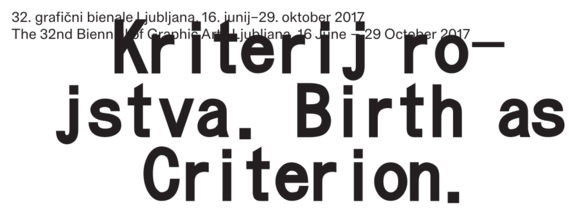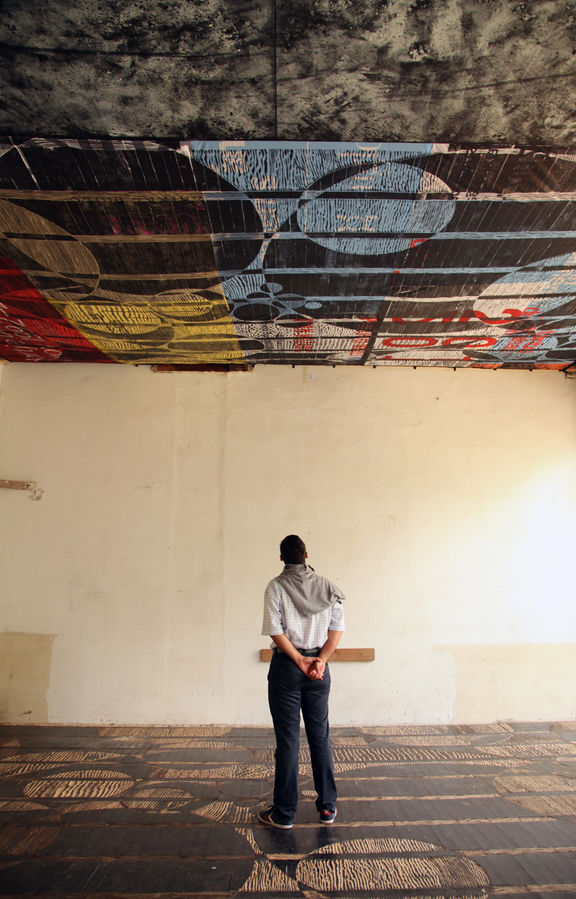Difference between revisions of "Biennial of Graphic Arts"
m |
Maja Škerbot (talk | contribs) (working, vmesno shranjevanje) |
||
| Line 26: | Line 26: | ||
}} | }} | ||
| − | The festival’s mission is to offer a critical review of contemporary developments in reproductive techniques and to point out the main streams which have influenced the development of contemporary graphic art. | + | ==Mission and history== |
| + | The festival’s mission is to offer a critical review of contemporary developments in reproductive techniques and to point out the main streams which have influenced the development of contemporary graphic art. Through its history The Ljubljana biennial is marked by three wide phases: | ||
| + | * 1955 - 1990s | ||
| + | From the very beginning the aim of the Biennial was to exhibit the best works and the largest possible number of graphic artists representing contemporary trends on all continents. In line with this approach, the only selection criterion was the quality of a limited edition print in any printmaking technique. During the Cold War, which cut short virtually every dialogue between the West and the East, the organizers of the Ljubljana Biennial nevertheless managed to bring together artists not only from the two opposing poles but also from the “Third World.” | ||
| + | |||
| + | * 1990s - 2001 | ||
| + | During the 1990s a new perspective on art that was in favor of reproduction and multiplication techniques gained a foothold, thus creating favorable circumstance for the reaffirmation of the Biennial the revitalization of the concept. Towards the end of the 1990s a new, more modern organizational approach was adopted. National presentations of artists gave way to individual presentations. The organizer of the Biennial appointed curators and the number of selected artists was radically reduced. Participating artists were represented by more works or a project. Consequently, the 20th, 21st, 22nd and 23rd Biennials indeed introduced new features. | ||
| + | |||
| + | * 2001-today | ||
| + | A truly radical change occurred with the 24th International Biennial of Graphic Arts in 2001. It was marked by certain changes, with emphasis placed on the substance of graphic arts in the context of newly emerging global art and the new internal organizational structure. Since than each edition offer the new approach. | ||
| + | |||
| + | |||
| + | Past programme selections have included work by artists such as Albers, Agam, Anuszkiewicz, Bill, Martin, Riley, Klein, Polk-Smith, Vasarely, Soto, Mauvigner, Bruno Munari, Frank Stella, Tetsuo Yamashita, Kim Seung Yeon and Bogdan Borčić. | ||
| + | |||
| + | |||
| + | ==Venues== | ||
| + | Next to the organising gallery [[International Centre of Graphic Arts]] at the [[Tivoli Mansion]] the Biennial takes place at several Ljubljana locations, including [[Museum of Modern Art Ljubljana]], [[Cankarjev dom Culture and Congress Centre]], [[Tivoli Mansion]] and a range of different urban open air venues. Based on the new concept of cooperation with the local scene and its protagonists, the recent edition extended venues to Galerija Alkatraz, Galerija Ganes Pratt, Galerija Jakopič, Galerija Kapsula, and Galerija Škuc. | ||
| + | |||
| + | ==Prizes and retrospective exhibitions of the winners== | ||
The gallery at [[Tivoli Mansion]] presents regular retrospective exhibitions of prizewinners from the previous Biennial. In 2001 one of the prizewinners was Damien Hirst and in 2003 a unique show of his drawings was organised in co-operation [[British Council Slovenia]] and exhibited at Tivoli Mansion. | The gallery at [[Tivoli Mansion]] presents regular retrospective exhibitions of prizewinners from the previous Biennial. In 2001 one of the prizewinners was Damien Hirst and in 2003 a unique show of his drawings was organised in co-operation [[British Council Slovenia]] and exhibited at Tivoli Mansion. | ||
| − | == | + | ==Influences== |
| − | + | The event gained through years huge respect and influenced many international scenes and events. The Biennial in its early stage became the model for other graphic art events and biennials in the world: in the 1950s in Tokyo and Grenchen (Germany), in the 1960s in Krakow and Florence (Italy 1968) and in the 1970s in Bradford (UK) and Fredrikstad (Norway). Among still existing graphic biennials as the Biennial in Krakow, the Triennial in Tallin (it evolved from the Biennial of Graphic Arts of Baltic republics into an international triennial of graphic arts) and Grafika Creativa in Finland, the Ljubljana International Biennial of Graphic Art is still the flagship. Further, the biennial caused the establishment of the Ljubljana International Centre of Graphic Arts in 1955, before the secretariat was part of the Museum of Modern Art. Finally, the international exhibition in Ljubljana also had a crucial influence on the development of Slovenian artists and of the Ljubljana School of Graphic Arts. | |
| + | |||
==See also== | ==See also== | ||
Revision as of 22:17, 27 January 2010
-
to
2 Jan 2011
17 Apr 2011
Mapping. Hits from the Ljubljana International Biennial of Graphic Art curated by Lilijana Stepančič in the frame of the 15th Tallinn Print Triennial
Mission and history
The festival’s mission is to offer a critical review of contemporary developments in reproductive techniques and to point out the main streams which have influenced the development of contemporary graphic art. Through its history The Ljubljana biennial is marked by three wide phases:
- 1955 - 1990s
From the very beginning the aim of the Biennial was to exhibit the best works and the largest possible number of graphic artists representing contemporary trends on all continents. In line with this approach, the only selection criterion was the quality of a limited edition print in any printmaking technique. During the Cold War, which cut short virtually every dialogue between the West and the East, the organizers of the Ljubljana Biennial nevertheless managed to bring together artists not only from the two opposing poles but also from the “Third World.”
- 1990s - 2001
During the 1990s a new perspective on art that was in favor of reproduction and multiplication techniques gained a foothold, thus creating favorable circumstance for the reaffirmation of the Biennial the revitalization of the concept. Towards the end of the 1990s a new, more modern organizational approach was adopted. National presentations of artists gave way to individual presentations. The organizer of the Biennial appointed curators and the number of selected artists was radically reduced. Participating artists were represented by more works or a project. Consequently, the 20th, 21st, 22nd and 23rd Biennials indeed introduced new features.
- 2001-today
A truly radical change occurred with the 24th International Biennial of Graphic Arts in 2001. It was marked by certain changes, with emphasis placed on the substance of graphic arts in the context of newly emerging global art and the new internal organizational structure. Since than each edition offer the new approach.
Past programme selections have included work by artists such as Albers, Agam, Anuszkiewicz, Bill, Martin, Riley, Klein, Polk-Smith, Vasarely, Soto, Mauvigner, Bruno Munari, Frank Stella, Tetsuo Yamashita, Kim Seung Yeon and Bogdan Borčić.
Venues
Next to the organising gallery International Centre of Graphic Arts at the Tivoli Mansion the Biennial takes place at several Ljubljana locations, including Museum of Modern Art Ljubljana, Cankarjev dom Culture and Congress Centre, Tivoli Mansion and a range of different urban open air venues. Based on the new concept of cooperation with the local scene and its protagonists, the recent edition extended venues to Galerija Alkatraz, Galerija Ganes Pratt, Galerija Jakopič, Galerija Kapsula, and Galerija Škuc.
Prizes and retrospective exhibitions of the winners
The gallery at Tivoli Mansion presents regular retrospective exhibitions of prizewinners from the previous Biennial. In 2001 one of the prizewinners was Damien Hirst and in 2003 a unique show of his drawings was organised in co-operation British Council Slovenia and exhibited at Tivoli Mansion.
Influences
The event gained through years huge respect and influenced many international scenes and events. The Biennial in its early stage became the model for other graphic art events and biennials in the world: in the 1950s in Tokyo and Grenchen (Germany), in the 1960s in Krakow and Florence (Italy 1968) and in the 1970s in Bradford (UK) and Fredrikstad (Norway). Among still existing graphic biennials as the Biennial in Krakow, the Triennial in Tallin (it evolved from the Biennial of Graphic Arts of Baltic republics into an international triennial of graphic arts) and Grafika Creativa in Finland, the Ljubljana International Biennial of Graphic Art is still the flagship. Further, the biennial caused the establishment of the Ljubljana International Centre of Graphic Arts in 1955, before the secretariat was part of the Museum of Modern Art. Finally, the international exhibition in Ljubljana also had a crucial influence on the development of Slovenian artists and of the Ljubljana School of Graphic Arts.




